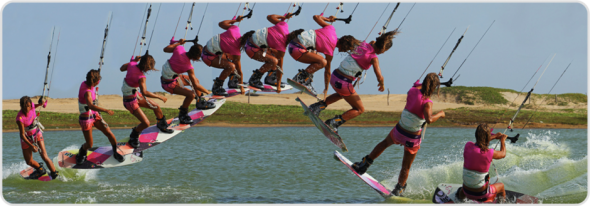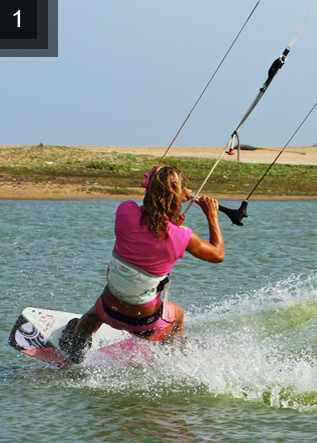Indy Pop to Blind
Before trying Indy pop to blind trick you must be reading well below instructions and practice it with right way. You can have every possible trill which is there in kite surfing. By understanding what to do and how to do can make all the difference.
And as we have often said it’s a great way to freshen up and reignite your passion fats move that you already have in the bag – so it’ll not only look the puppy’s but also feel do booth! Here we have a hooked in pop to blind with a back hand grab on the toe side rail in between your feet. You should already have the ability to pop around to blind and ride and if you don’t then hopefully this will be the incentive you need to learn.
The Set Up- Pic A
When you search for your pop you will require two things, the obvious one being speed with a dose of power and the less obvious one is a good body position, which is always much required. Whilst learning you can afford yourself the luxury of a third one, which is lift from the kite. No need to have it down at 45° when a forgiving 1 or 11 o’clock will help you on your way. Here we can see in the image that the body position as the rider carves back up into her pop. Her front leg is extended, meaning that her hips, and weight are pushed back towards the tail of the board and her shoulders are also leaning back. Surfer adopted this position before she turned off the wind and has held it throughout her carves. This very sturdy position enables her to pop explosively off her back leg. Before we continue take note that your hands should be centered on the bar and your kite parked still.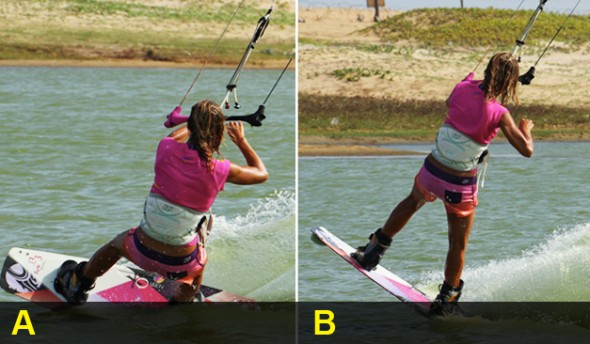
The Explosion Pic B
From such a solid set up the pop should be easy and simple. As long as you turned off the wind before carving up both the kite and the board will behave, that is to say the kite will give you something to pop against and your board won’t slow down too much as you carve. To get maximum pop you must keep your shoulders back and upwind of the board, your bum low and close to the water and you must not soften your back knee as you carve up. The rider has stamped down hard against the board with her back foot, explosively kicking herself away from her edge, and with her weight back and she takes off nose first. In anticipation of not having much time to grab she is already releasing her back hand from the bar as she stamps.
Board Up Pic C
As with any pop you need to wait until you’ve extended your body to get full elevation up, but as soon as you have it’s chop-chop to get the grab in. In picture, having already released hand, her next job is to bring her knees up towards her so that the board is within grabbing distance. The rider looks down towards where she’ll grab as she lifts the board and keeps her knees apart so that there is room for her arm to reach down towards the edge of the board. Also as a result of popping hard the back of her board kicks around and out slightly which has the effect of turning the rider back and away from the kite. This is good as it pushes which in turn gives her more room to reach down with her back hand.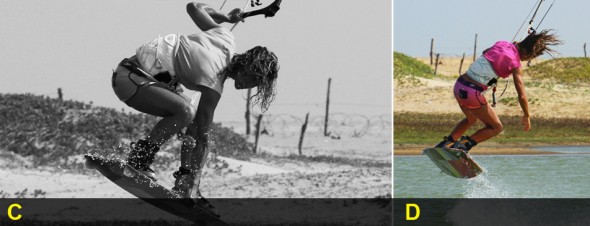
The Grab Pic D
With the board flicking around, roots for the back hand to reach down and the knees pulling everything up she can happily grab the board for a solid Indy. In this picture you can see the result of all that has gone before – the bar is in front of her and she has plenty of roots to reach and hold the grab without the need to be a contortionist. Whilst you have the grab sirs to keep the bar in on the sweet spot so that you’ll have a modicum of support from the kite, you’ll keep your forward momentum for the landing, and you’ll be able to dump the pull when you need to turn to blind.
Throw the Blind Pic E
A very good thing about the grab is that it naturally makes you stall your turn or throw to blind. Blind is always a last second movement, hence why we can do a by pop to blind. The higher you go, the longer you have to wait in order to keep your balance and control the landing. Once you feel that you’ve got the grab and you know that you’re coming data it’s time to turn. The action will come from your hips and your back leg whilst your free arm will balance you. The rider has released her grab and now commits to blind. To turn the board she twists her hips and pulls her back leg up towards her bottom and around towards the water. The board will naturally want to fall tail first so she focuses on pulling her back leg up. By doing this she will rotate around her harness hook and should make it all the way.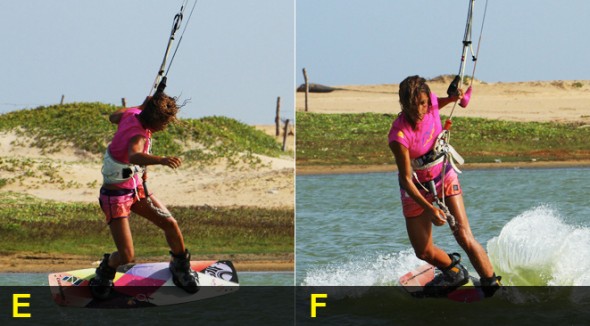
Landing Pic F
Landing this should be as per your pop to blind, though chances are as you’ve had more height you will have less momentum to keep you going once you plant the board. Make an effort to keep your back foot up so that you can plant the front of the board into the water for landing. This way as the nose catches the board will pivot off the wind more and you’re more likely to keep moving. If you land flat on your edge you’ll just stop. You can see that the rider has landed nose first with her front leg fairly straight, whilst her back leg is bent so that the board will turn further away from the wind on landing
She is already in her default blind position so that she will keep moving. If you have slowed too much pull the bar in to get some oomph from your kite.
Top Tips
- First of all you should practice the Indy if you never tried it before.
- Getting the board flicking you slightly around on take-off does make the movement of turning to blind in the air much easier as you have less far to turn and thus your body is in a better position.
- Try looking back at where you came from as you grab, this will help you turn during your Indy.
- Although we’ve said you don’t want your kite too low, don’t have it any higher than 11 or 1 o’clock. It still needs to be pulling forward to allow for some flick, an easy grab, and momentum on landing.
Common Problems
- If you can’t reach to the grab then ensure you’re popping hard enough. The pop will help you lift the board as the water will cork the board back up at you.
- Also make sure you turn to face slightly back to get the bar and your harness out of the way.
- If you’re falling backwards as you land. If your body is further downwind than the board when you land you need to sheet the bar out as you throw the blind.
- If you’re landing and then falling chances are that you’re landing flat or tail first, so concentrate on keeping that back foot up and close to your bottom so that the board can pivot.
Keystones
- Turn up and pop hard
- Release back hand and look for grab
- Lift board and look back
- Throw to blind using hips and back leg
- Keep back leg up to land nose first
Sent Back Roll Indy Grab
Welcome to kitesurfingtrick.com. Our Endeavour is forever to come up with most excellent kite surfing tricks. Indy grab is an exceptional trick, which requires your both legs to be lifted thus this grab makes your back rolls feeling fresh. Riding boots are easy to reach and grab in this trick. Even if you are not riding shoes, the Indy is again the number 1 option to stretch your back and feel great with adventurous Indy moves.
Some of the basic rules and principles, which we have gathered in this article, are as below. This will allow you to do it with exact way with no harm to body.
1. The very first step and take off
First in this trick rider comes in a resisting on a good edge heading firmly upwind with the kite at 11 or 1 o’clock position. Rider’s front leg is extended and pushed forward; hips are forced back towards the end of the board, shoulders are leaning back and rider’s back leg is bowed.
Image number – 1
Here is the first step and in this picture the rider resisted with good edge & sent the kite pretty hard from 11 o’clock so that the pull up will come early on. Now at reaching 12 o’clock position rider will stamp up on back leg in popping position and there pull the bar in. Rider pulls the bar in to stop the kite’s movement, avoiding it from going further back. Though rider has carved into this rotation, however rider hasn’t thrown head over front shoulder.
This would certainly aid you to obtain a smooth rotation righter than an unrestrained spin.
Image number – 2
Okay! Now on second step first extend then lift. You must position your body as soon as you depart from water, if you wait extra then further you will spin and the smaller amount of time you will have. Please remember, this also doesn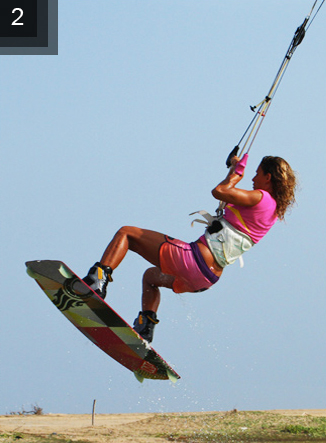 ’t mean that you must be holding the board as soon as fins departs the water, however if you place your body in right position then grab will be trouble-free to obtain. Rider lifts both knees up and this helps with slowing the rotation down. Also you can’t toss your head around into the rotation if you are seeking a firm grab.
’t mean that you must be holding the board as soon as fins departs the water, however if you place your body in right position then grab will be trouble-free to obtain. Rider lifts both knees up and this helps with slowing the rotation down. Also you can’t toss your head around into the rotation if you are seeking a firm grab.
Image number – 3
If you succeed in carrying you’re both knees right up into your chest height then the grab must be a child play for you. The blockages with the Indy are your control and the kite. Here the kite lifts you and strap up holds and you will be planning to aim the right for the middle of your board.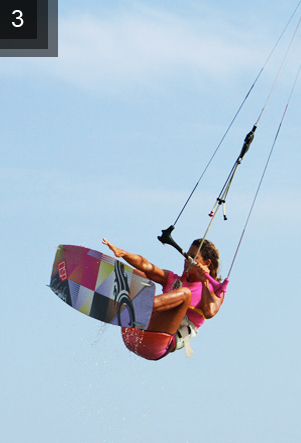 Bring the board up towards your extended hand; please let your stomach and legs do the work here as you can’t bend down with such force. Permit your head & shoulder to rock back into a comfortable sitting position as your knees comes up. You can also observe here that the rider hasn’t rotated much since the last image. Rider is rotating slowly and is quick to get the board up.
Bring the board up towards your extended hand; please let your stomach and legs do the work here as you can’t bend down with such force. Permit your head & shoulder to rock back into a comfortable sitting position as your knees comes up. You can also observe here that the rider hasn’t rotated much since the last image. Rider is rotating slowly and is quick to get the board up.
Here, while seeking for the firm grabs keep your head between your shoulders and also keep the rotation slow. In this position you will use a large time keeping the bar pulled in with only your front hand, the kite will simply move from behind you to somewhat in front of you.
Image number – 4
Hold it tight, once you get the grab. Slower your rotation & try to hold the grab as long as possible. 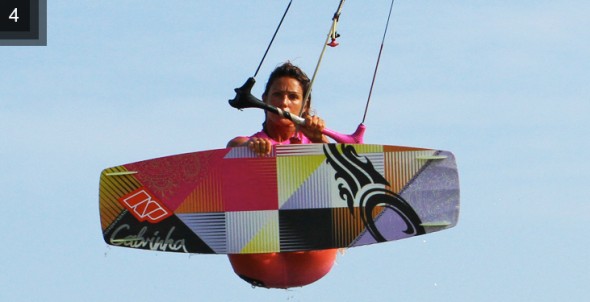 Enjoy it; it’s very cozy as you can also see that rider’s position in the air is almost the same as setting on beach. If you have sent the kite solid and frozen it above you while take off, you must be able to settle down and except you sense that kite dragging too far forward, oppose the enticement to look over your shoulder.
Enjoy it; it’s very cozy as you can also see that rider’s position in the air is almost the same as setting on beach. If you have sent the kite solid and frozen it above you while take off, you must be able to settle down and except you sense that kite dragging too far forward, oppose the enticement to look over your shoulder.
Image number – 5
In this position, If your rotation is controlled and the kite is not too far forward you can hold the grab until just before landing. You would eventually need to turn your head over your shoulder to make sure you complete 360 degree and perfec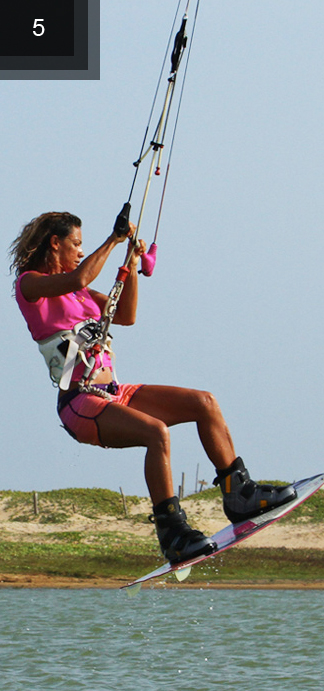 t landing. Mark your landing and obtain the board pointing downwind.
t landing. Mark your landing and obtain the board pointing downwind.
When you discharge the grab, try to get both hands on the bar and provide it a good jump to aid you land downwind.
Top Tips
- Always begin with some back rolls, focusing on the send, upward take off and slow rotation and after that start to take knees up and roll back in your yoke.
- If slow rotation is your problem, then try looming it as you would for a back roll transition, and also with low speed
- you will see it much easier.
- Also have a close look to images
Common Problems
- If you are over rotating your back rolls, ensure that you don’t carve up exceptionally during your take off.
- You must go from the edge that you have approached with and then kick up and around.
- Ensure that you dive the kite for the landing as this will discontinue your revolution and pull you off down wind.
- Ensure your hands are centered on the bar and also keep in mind to send the kite and further it goes back, then it needs to return back. There would be a perfect balance as per kite’s size.
Keystones
- Always send kite positively
- Lift knees and rock then get ready for the grab
- Fine solid edge with straight front leg & back leg resisting
- Pop up into the back roll
- Do turn your head and jump to accomplish rotation
Here is a video that shows how to spice up your back roll with an indy grab
